Home | Category: Christian Prayers and Rituals
CHRISTIAN SYMBOLS
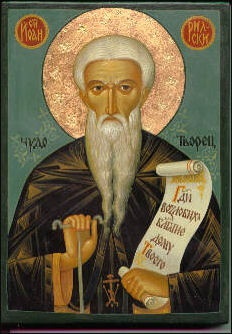
Halo on Russian icon The cross is the main symbol of Christianity (See Below). Angels and saints are often depicted with halos around their heads, symbolizing God’s holiness radiating from them. The idea of the halo did not originate with Christianity. Gods and spirits in ancient Hindu, Indian, Greek and Roman art sometimes had light radiating from their heads.
Candles are symbols of the light of Christ and God. In the Gospels Jesus said “I am the light of the world.” Originally used as a means of illumination, candles are now used in most liturgical ceremonies and are placed on an altar after it has been consecrated through anointment. A blessing of candles, followed by a procession lies at the heart of the Candlemass celebration in early February. During the Easter Vigil, candles are a symbol of the risen Christ and the lighting of these candles is the climax of the entire liturgical year.
Christians produced their first images during the era of Roman Era on the walls of underground tombs, or catacombs. One of the earliest images was of a shepherd carrying a sheep on his shoulders, which some say is an image of Jesus while other say is a representation of God's love in seeking out sinners. Images from the Old Testament were also displayed. Some say many Christian symbols — crucifixes, rosaries, communion and holy water — can be traced back to the Egyptian Osiris cult. Osiris was a human who was resurrected as a god. [Source: Michael J. McClymond, “Worldmark Encyclopedia of Religious Practices”, 2000s, Encyclopedia.com]
Websites and Resources on Christianity BBC on Christianity bbc.co.uk/religion/religions/christianity ; Candida Moss at the Daily Beast Daily Beast Christian Answers christiananswers.net ; Christian Classics Ethereal Library www.ccel.org ; Sacred Texts website sacred-texts.com ; Internet Sourcebook sourcebooks.fordham.edu ; Christian Denominations: Holy See w2.vatican.va ; Catholic Online catholic.org ; Catholic Encyclopedia newadvent.org ; World Council of Churches, main world body for mainline Protestant churches oikoumene.org ; Online Orthodox Catechism published by the Russian Orthodox Church orthodoxeurope.org
RECOMMENDED BOOKS:
“Christian Symbols” by Rose Publishing Amazon.com ;
“A Complete Guide to Christian Symbols Hardcover” by Edward Riojas Amazon.com ;
“Practicing Theology: Beliefs and Practices in Christian Life”by Miroslav Volf and Dorothy C. Bass Amazon.com ;
“Mere Christianity” by C. S. Lewis Amazon.com ;
“Introduction to Christian Worship” by James F White Amazon.com ;
“The Oxford History of Christian Worship” by Geoffrey Wainwright and Karen B. Westerfield Tucker Amazon.com ;
“Ancient Christian Worship: Early Church Practices in Social, Historical, and Theological Perspective” by Andrew B. McGowan Amazon.com ;
“Lectures on the Christian Sacraments” by St Cyril of Jerusalem Amazon.com ;
“On the Sacraments of the Christian Faith (De Sacramentis)
by Hugh of Saint-Victor Amazon.com ;
“The Sacraments: Source of Our Life in Christ” by James Socias and Scott Hahn Amazon.com
Fishes and Doves As Christian Symbols
Fishes have been a Christian symbol since the early days after Christ’s death. They are symbols of Peter, the closest disciple to Jesus and the leader of the Apostles. Described by Jesus as “a fisher of men,” Peter was a fisherman by trade and was with Jesus from the beginning of his teachings. According to Matthew, Peter was the first to believe in the divinity of Jesus. He said: “Thou art the Christ, the Son of the living God.” Peter was present at most of the important events described in the Gospels.
The fish symbol is a primitive drawing of a fish made of two curving lines, or arcs. In the early days of persecution, it is said, if two Christians met they could identify themselves to each other by this symbol. One would draw an arc in the sand, and the other would draw a reverse arc to fashion the shape of a fish. There are two reasons this a powerful symbol. One is the reference in the Bible to Christians being fishers of men. The other is the fact that the Greek word for fish, ichthus, also forms, in Greek, the first letters of the words "Jesus Christ, Son of God, Savior." Thus, this simple symbol is like a secret code. Today the fish symbol is especially popular among evangelical Christians. [Source: Encyclopedia.com]
The dove, especially when depicted with a halo of three rings, represents the Holy Spirit and the three rings of the halo represents the Trinity. The image of a lamb symbolizes Jesus, the "lamb of God". A dove, with wings outstretched, symbolizes the Holy Spirit and is widely used by Evangelical Christians.
Development of Christian Imagery
Michael J. McClymond wrote in the “Worldmark Encyclopedia of Religious Practices”: After Constantine made Christianity legal in the fourth century, Christians erected basilicas, and the Christian artistic tradition then began to unfold in rich variety. Every episode in Jesus' life was treated in loving detail. His birth, baptism, crucifixion, resurrection, and ascension were especially common images. Not only biblical events but also the saints were commemorated in pictures and statues. Images of Mary and Jesus, the Madonna and Child, were among the most widespread. Pope Gregory I argued that images in church buildings were "books for the illiterate" and so had educational value. [Source: Michael J. McClymond, “Worldmark Encyclopedia of Religious Practices”, 2000s, Encyclopedia.com]
During much of the seventh and eighth centuries, however, controversy concerning the use of images raged in the eastern Mediterranean. The Iconoclasts argued that icons, or Christian images, were a violation of the second of the Ten Commandments — "you shall not make for yourself an idol" (Exodus 20:4) — and so had to be removed from churches. Those who insisted that reverence shown to an icon was reverence shown to God ultimately triumphed. Veneration for icons, such as kissing images and lighting candles, continues to play a major role in Orthodox Christianity. While the Western church tends to think of images as educational aids, the Eastern church has adopted a more explicitly devotional attitude toward them. of God's love in seeking out sinners. Images from the Old Testament were also displayed.
Some Protestants did away with all images, while others abolished three-dimensional images, thought to be idolatrous, and yet allowed two-dimensional images in books or in stained glass. A simple cross, without Jesus' body, is one of the few symbols widely shared among Protestant groups. Protestants sometimes use images of books or open pages, a testimony to the importance of the Bible in their tradition.
Christian Gestures and Postures
 There are four main postures recognized by the Catholic church: standing, sitting, kneeling, and more rarely, prostration. Standing is regarded as the most noble. It symbolizes mankind and imparts respect. It is regarded as the best position for readings scriptures and praying. The sitting position represents peaceful openness, best suited for listening to readings or sermons. Kneeling is a demonstration of supplication and humility before God and more intimate and personal prayers. Protestation consists of lying outstretched on the ground. It is reserved for solemn moments such as when a person is about to pronounce his religious vows or when the death of Jesus is read during the Good Friday reading of the Passion.
There are four main postures recognized by the Catholic church: standing, sitting, kneeling, and more rarely, prostration. Standing is regarded as the most noble. It symbolizes mankind and imparts respect. It is regarded as the best position for readings scriptures and praying. The sitting position represents peaceful openness, best suited for listening to readings or sermons. Kneeling is a demonstration of supplication and humility before God and more intimate and personal prayers. Protestation consists of lying outstretched on the ground. It is reserved for solemn moments such as when a person is about to pronounce his religious vows or when the death of Jesus is read during the Good Friday reading of the Passion.
Specific hand and arm gestures are used in liturgical rites, blessings, anointments and particularly in consecrations. As a symbol of purity, for example, a priest washes his fingers after the offertory and after communion. Hands are kept clasped together when a priest is officiating or when he has nothing to do.
The liturgy requires Catholics to make several hand gestures: 1) crossing themselves (See Below); 2) tracing a small sign of the cross with the thumb over the forehead, mouth and heart at the moment the of the announcement of the Gospels; and 3) shaking hands — done in lieu of the kiss of peace which is usually given before communion — as a sign of chaste affection.
Orthodox Christians are big on kissing: they kiss icons, the kiss priests, they kiss the floor. They also spend a lot of time lighting candles, crossing themselves, polishing stuff and filling bottles with holy water.
Crossing oneself — making the sign of the cross on one’s body — joins the Holy Trinity with the redemption of Christ as one recites the name of the Father, Son and Holy Ghost. As a believer says “In the Name of the Father, the Son and the Holy Ghost, Amen” he touches his forehead when saying “Father,” stomach when saying “Son” and crosses his shoulders when saying “Holy Ghost.” Catholics cross their shoulders left to right and Orthodox Christians cross theirs right or left.
Other gestures and actions include: 1) washing the feet during Maundy Thursday, reenacting the gesture performed by Christ during the Last Supper. 2) bowing the head before symbols of divine presence: the altar, the cross and the Bible; 3) A genuflexion (bending at least one knee towards the ground) is required in all churches when passing in front of the Holy Sacrament. 4) Monks bow down low a the end of each psalm when they chant the “Glory be to the Father and to the Son and to the Holy Spirit” during the celebration of their offices and during certain ceremonies.
Foot Washing
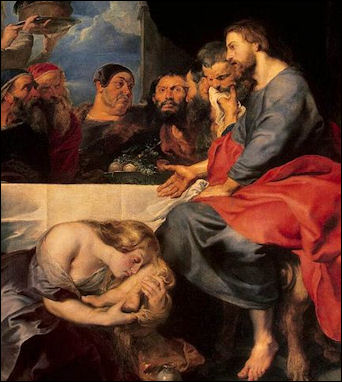
Mary Magdalene kissing the feet of Jesus
Every year, millions of Christians around the world take part in a foot-washing ritual around Easter. Candida Moss wrote in the Daily Beast: The basis for washing feet on Holy Thursday is the account of the Last Supper. According to the Gospels, Jesus washed the feet of the disciples before his final meal with them. At the time, the disciples were debating their relative position in the kingdom of heaven. By taking on the role of a servant and washing the feet of his followers, Jesus was highlighting their pride. It was a subversive act that threw shade on the apostles’ ambitions. It was absorbed into Christian ritual almost immediately, being incorporated into baptismal practice across the empire from the second century onwards. And, in the 16th century, radical reforming Protestants tried to re-create the faith of the apostolic era by reintroducing foot washing into their daily lives. [Source: Candida Moss, Daily Beast, March 27, 2016]
Feet are a bodily focal point in the Bible. The first thing that God commands Moses to do in Exodus is to take off his shoes. He was in a holy place, God said, and he was muddying the place up. Jesus is on the receiving end of the gesture on several occasions. In John, when he visits Lazarus, Lazarus’s sister Mary washes his feet, and in Luke an unnamed woman washes Jesus’ feet and anoints them with oil. Both women use their own hair to pat his feet dry.
The practice was taken over not only by popes but also by priests in general and even monarchs. Until 1689, English monarchs personally washed the feet of the poor. The ritual was often accompanied by the distribution of alms and clothing. But in 1689 the custom was suspended by the Protestant co-regents William and Mary, who elected to distribute coins instead. (To this day Elizabeth II still honors the custom and gives special minted money to a carefully selected group.)
Crosses and Christianity
The cross is the primary symbol of Christianity. It is a comprised of two intersecting lines. It represents the suffering, Crucifixion, Atonement, and Resurrection of Jesus. For some it symbolizes Christ’s love for humanity in dying for its sins, the life of self-denial to which he calls his followers and Christ's victory over death and sin. The cross is a strong symbol in churches and often appears on their roofs and in homes. Its presence recalls the sacrifice of Jesus Christ. The cross is also worn by many Christians around their necks and defines the floor plan of many churches. [Source: Michael J. McClymond, “Worldmark Encyclopedia of Religious Practices”, 2000s, Encyclopedia.com]

The cross originally did not signify a crucifixion, some scholars say. It stood for "St. Andrews mark,” in which people vowed to be honest to his sacred name. Andrew was one the Apostles. He is said to have been crucified on an X-shaped cross in Patras Greece.
Michael Symmons Roberts wrote for the BBC: “Paradoxically a symbol of suffering and defeat but also of triumph and salvation, the cross is the universal Christian symbol, acknowledged by all denominations as the single visual identifier of their faith. While Good Friday marks the Passion of Christ and his crucifixion, Roman Catholic and Eastern Orthodox Christians also reflect on the cross as a symbol of salvation with the feast of The Triumph of the Cross on 14th September. [Source: Michael Symmons Roberts, September 12, 2011,BBC |::|] “The cross on which Jesus was executed 2000 years ago has been a symbol for his followers from very early on. At first, they were scared to display it publicly in case they were persecuted or mocked. But after the Emperor Constantine converted to Christianity in the 4th Century, crucifixion was abolished as a punishment, and the cross was promoted as a symbol of the Son of God. |::|
“The belief that the cross can ward off evil and protect the wearer goes back a long way. From the early centuries of Christianity, it's been a custom among Christians to make the sign of a cross on themselves with a hand. At first, it was done with the thumb on the brow, on rising in the morning, settling to eat, starting a journey, going to bed. |::|
“Then it grew into the fuller gesture we have today - from head to heart, and shoulder to shoulder. But this symbol means so much to people, they still can't agree on how it should be done. Should the sign be made with the index AND middle fingers, because Jesus had two natures - God and Man? Should it be made with three fingers to signify the trinity? Or five, to number the wounds of Jesus on the cross? Even today, the Catholic west crosses itself from left shoulder to right, and the Orthodox east does it from right to left. Clearly, this symbol still has the power to divide opinion, and some of the hottest debates about the meaning of the cross in recent years have been conducted not in churches, but in art galleries.” |::|
See Separate Articles: CRUCIFIXION OF JESUS, EVENTS AND THE STATIONS OF THE CROSS a href="https://factsanddetails.com/world/cat55/sub390/entry-5756.html"> factsanddetails.com ; CRUCIFIXION: HISTORY, EVIDENCE OF IT AND HOW IT WAS DONE europe.factsanddetails.com
Types of Christian Crosses
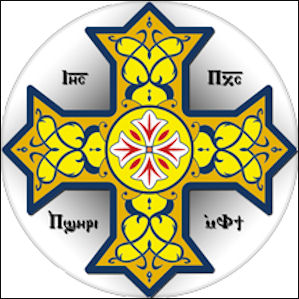
Coptic Orthodox Cross
There are number of different kinds of crosses. The standard — Latin, or Roman Catholic cross — has a vertical line that is longer than the horizontal line.An empty cross shows that Christ has risen from the dead. The crucifix of the Catholic church often has an image of crucified Jesus hanging from it. The Protestant one is more clean and simple. The whiteness symbolizes purity; the brightness, the Light; and 90 degree angles perfection and the direction of God.
Michael J. McClymond wrote in the “Worldmark Encyclopedia of Religious Practices”: The Greek cross has four arms of equal length, while the Latin cross has three arms of roughly equal length, with one longer arm. Eastern crosses sometimes have small crossbars near the ends of the arms. In honor of Andrew, who is said to have died on a cross in the form of an X, the Russian cross has three arms across the vertical shaft, two parallel to the ground and one at a 45-degree angle. [Source: Michael J. McClymond, “Worldmark Encyclopedia of Religious Practices”, 2000s, Encyclopedia.com]
Pectoral crosses are large crossed worn around the necks of Catholic prelates in the front of the chest (hence pectoral, for chest). They are large and meant to be seen from a distance. They are worn over vestments during religious ceremonies but are too large and cumbersome to be worn on the streets.
Importance of the Crucifixion But Not Crosses to Early Christians
The crucifix, a three-dimensional representation of Jesus on the cross, appeared in about 1000 in the Rhineland. It subsequently became one of the most distinctive Christian symbols and is especially associated with Roman Catholicism. Orthodox Christians have not generally favored the crucifix, since they view the cross as Jesus' moment of triumph.

Robin M. Jensen wrote in the Washington Post, “For almost 1,000 years, the Christian church emphasized paradise, not Crucifixion,” two authors wrote in UU World magazine; in Slate, scholar Larry Hurtado claimed that “there was, in short, little to be gained in proclaiming a crucified saviour in that setting in which crucifixion was a grisly reality,” noting that “some early Christians tried to avoid reference to Jesus’ crucifixion.” [Source: Robin M. Jensen, Washington Post, April 14, 2017]
“It is true that crosses were extremely rare symbols for Christians to use before the mid-4th century. Moreover, the first images of crosses portray them more as slender, gemmed staffs than as sturdy instruments of execution. Depictions of Jesus’ crucifixion were even more rare, not occurring with any regularity until the 6th century.
“Yet there’s a reason this is surprising: Christian authors, poets and preachers wrote and spoke at great length about the significance and meaning of Jesus’ death on the cross. In the 2nd century, Christian thinker Justin Martyr wrote that “when they crucified Him, driving in the nails, they pierced His hands and feet; and those who crucified Him parted His garments among themselves,” emphasizing the humiliation and suffering of Jesus’ execution in a long dialogue with a non-Christian interlocutor. Tertullian, another prolific early Christian writer, also meditated at length on the crucifixion and its theological meaning.
“While explaining the cross or crucifix’s absence from visual art may be difficult, timing its appearance with the rise of pilgrimage to the Holy Land and the sites of Jesus’ life, death and resurrection provides helpful clues. By the end of the 4th century, pilgrims were traveling to Jerusalem, where they could visit Golgotha and venerate a relic of the “true cross,” supposedly discovered by the Roman Empress Helena. Some even were privileged to receive a fragment of the holy wood. The image of the cross and the crucifix may be linked with pilgrims’ desire to re-create the scene in its historical setting, and the proliferation of cross images in the West may have to do with the cross-related souvenirs some pilgrims brought back.”
Christians Adapted the Cross from Older Symbols
Robin M. Jensen wrote in the Washington Post, “ This idea has some convinced followers. According to Jehovah’s Witnesses, for example, various authorities “have linked the cross with nature worship and pagan sex rites.” The Church of the Great God, another denomination, likewise claims that “long before the coming of Christ, pagans used the cross as a religious symbol.” [Source: Robin M. Jensen, Washington Post, April 14, 2017]
“Yet there is no evidence that Christians intentionally borrowed the cross from pre-Christian cultic symbols. While it is true that many ancient religions used symbols similar to the cross (and that Egyptian Christians even adapted the ankh, a hieroglyph for “life”), two intersecting lines are a simple and very common figure. This makes it difficult to assert that early Christians consciously adopted a particular sign rather than inventing one specifically referring to their unique story of Jesus’ death upon a cross. While it is easy to see similarities in religious artwork from various traditions, it is also easy enough to locate distinctions among them. The Christian cross, with all its associated symbols (anchors, letters, ploughs and more), is a distinct feature of Christian art.”
Incense and Christianity
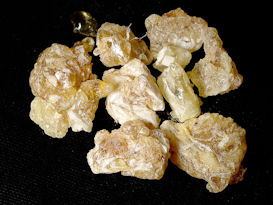
Frankincense Incense — an aromatic gum, traditionally frankincense or myrrh , that gives off perfumed smoke when lit — is used by Christians in rituals as a purifying agent and to create a spiritual atmosphere. It is also used in rituals in other religions, particularly Buddhism, Hinduism and Chinese religions. The incense used by Catholic is supplemented with benzoin, That used by Orthodox Christians is often lit in front of icons and normally is highly perfumed, often with roses.
In the Old Testament incense is mentioned in the psalms and when God told Moses to offer it once or twice day. In the New Testament, Zechariah was lighting incense when he told the angel Gabriel about the birth of John the Baptist: “Another angel, who had a golden censer, came and stood in front of the throne; and so from the angel’s hand the smoke of the incense went up in the presence of God and with it the prayers of the saints.” The Three Wise men presented frankincense and myrrh at the birth of baby Jesus.
Incense is often burned in a censor, an ornamented fragrance burner with holes for the smoke to pour out of. It is held aloft with three chains. Using a spoon a believer take some incense from an incense-boat and places it on the burning coals housed in the cassolette of the censor. The smoke is spread by swinging the censer. The person in charge of lighting and swinging the censer is called a thurifet.
Christian Holy Water and Holy Oils
Holy water is a key element of many Christian rituals, blessings and ceremonies. During the baptism of a child it is sprinkled on the head of the child (ablution). During a Catholic funeral, it is gently poured on the body of the deceased as a sign of purification and sprinkled in the coffin and the tomb. Holy water is also used in the blessings and asperges at the beginning of Sunday and the washing of hands in the offertory.
Blessings involving water and holy water have been church traditions for some time. A basin of holy water at the entrance to a church is an invitation to believers to cross themselves after wetting the tips of their fingers in it. Holy water is water that has been blessed by a priest. It can be requested and taken home. Holy salts can be added for flavor and as a symbol of preservation.
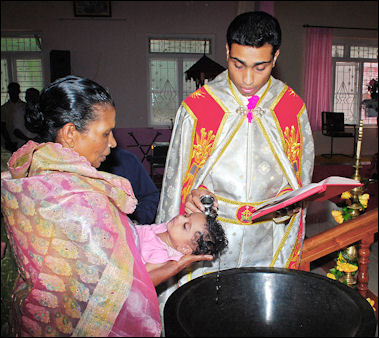
Holy water used in a baptism Holy oils have traditionally symbolized the consecration of a person by God to be a monarch, priest of prophet . “Messiah? and “Christ” both mean the “anointed one” (in Hebrew and Greek respectively). Anointment is still a key part of the coronation of the kings and queens on England and other monarchs. Objects and buildings can also be consecrated.
Oil is a symbol of joy and beauty. One of the psalms goes: “You love uprightness and detest evil. This is why god, your god, has anointed you with oil of gladness, as none of your rivals.” It has also been used since Biblical times as a balm to relieve pain and loosen tight muscles.
The Catholic Church emphasizes three kinds of holy oils: 1) the oil of “catechumens”, which gives the strength of the Holy Spirit to those who fight evil; 2) oil of “anointing”, used in sacrament of anointing the sick (unction, See Unction); and 3) the “holy chrism”, a fragrant oil used for ointments in consecration. After baptism holy oil marks the top of the head. During confirmation it crosses the head. After an episcopal ordination it is rubbed into the top of a new bishop’s head, or on the hands of a priest. During a dedication it is spread across the table of an altar .
During the “chrism” mass in the morning of Maundy Thursday (three days before Easter) a bishop solemnly blesses oil of the catechumens and the oil of anointing before finally consecrating the holy chrism. The oils are then stored in silver of gold ampulla (flasks) or altar cruets.
Christianity, Rosary Beads and Chords
Christian rosary beads typically have 50 beads separated in groups of ten by five large individual beads for a total of 55 beads. They are used by clergy and laity as aids in the reciting of certain kinds of repetitive prayers. Catholics generally count their rosary beads while they say prayers. Each rosary has a kind of tail with three consecutive beads, with two individual beads, at each end, finishing with a cross.
The rosary is widely used by Catholic to say prayers to the Virgin Mary with a believer saying 50 Hail Marys, five “Our Fathers” and five “Glory be to the Father” by ticking off a bead for each “Hail Mary” and saying “Our Father” each time the larger individual beads are hit. The cross on the tail is the starting point for each prayer sequence. On the cross the believer recites “I believe in God”; on the first individual bead he says “our Father,” then three “Hail Marys” and finally “Glory be to the father.” In this way the rosary honors the Trinity, the Cross and the Virgin all at the same time. The “Hail Mary” marks the greeting given to Mary by the angel Gabriel during the Annunciation (Announcement of the Birth of Christ).

Rosary and Bible Greek Orthodox monks often use a chord with knots rather than rosary beads to count their prayers. They are given the chord by their monastery and use it when they pray, “Lord Jesus Christ, Son of God, have mercy on me, a sinner.”
The name rosary comes from “rosarium”, the Latin name for “rose garden.” Rosaries originally consisted 165 dried carefully rolled up rose pedals, sometimes darkened with lampblack. The rose was a symbol of the Virgin Mary. The use of beads reportedly date back to the early Christian era when ascetics in the desert used beads or pebbles to tick off their prayers with the understanding that the more prayers an individual said the better chance he had of getting into heaven.
Buddhists and Muslims also use rosary-type beads to counts prayers. Buddhist prayer beads are used to count of prayers in dominations of special numbers. Each time the beads are touched, a prayer is said and merit is earned. Praying 108 times is regarded as particularly meritorious because it “disturbs passions” of “mankind’s delusions” cited in Buddhist scripture.
Muslims carry “misbaha” beads (sometimes called "worry beads"), which are used to count the number or prayers that have been recited. They also give away the mood of the their owners. They way the beads are carried and moved around can convey nervousness, boredom and anger.
Image Sources: Wikimedia Commons
Text Sources:Internet Sourcebook sourcebooks.fordham.edu ; “World Religions” edited by Geoffrey Parrinder (Facts on File); “ Encyclopedia of the World’s Religions” edited by R.C. Zaehner (Barnes & Noble Books, 1959); King James Version of the Bible, gutenberg.org; New International Version (NIV) of The Bible, biblegateway.com; Christian Classics Ethereal Library (CCEL) ccel.org , Frontline, PBS, Wikipedia, BBC, National Geographic, New York Times, Washington Post, Los Angeles Times, Smithsonian magazine, The New Yorker, Time, Encyclopedia.com, Reuters, Associated Press, Business Insider, AFP, Library of Congress, Lonely Planet Guides, Compton’s Encyclopedia and various books and other publications.
Last updated March 2024

